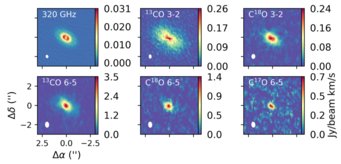
Protoplanetary disks: observations
Protoplanetary disks are the sites of planet formation. As such, the physical conditions in these objects determine the formation pathways and early evolution of planets while also providing the initial planetary chemical composition. Using millimeter interferometers such as NOEMA and ALMA we are now able to resolve both dust continuum emission and spectral line emission from the gas in protoplanetary disks. This allows us to investigate how physical and chemical properties change within individual systems. Additionally, these facilities allow us to explore broader trends through surveys of systems spanning a range of environments and ages. In the infrared, new instruments such as CRIRES+ on the VLT as well as MIRI and NIRSpec on JWST access emission from hot gas in the inner, terrestrial planet-forming regions of protoplanetary disks as well as spectroscopic features from ices.

In our group we combine observations with the development of novel analysis tools to constrain disk properties such as mass, temperature, and molecular abundances. Our work provides grounding truth for modeling studies of protoplanetary disks as well as observations of exoplanet atmospheres.
List of group members / associated members working on this: (Dr. Kamber Schwarz, Grigorii Smirnov-Pinchukov (associated), Dr. Dmitry Semenov (associated), Dr. Sierk van Terwisga, Dr. Giulia Perotti (associated)
